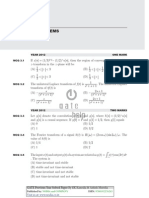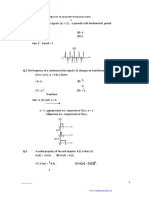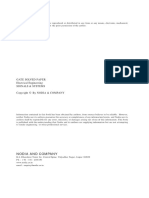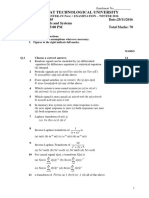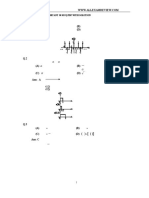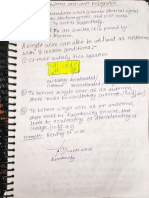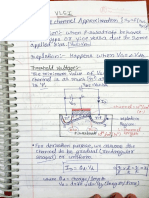0% found this document useful (0 votes)
143 views25 pagesZtranform Notes
Class Notes
Uploaded by
Hariom KumarCopyright
© © All Rights Reserved
We take content rights seriously. If you suspect this is your content, claim it here.
Available Formats
Download as PDF or read online on Scribd
0% found this document useful (0 votes)
143 views25 pagesZtranform Notes
Class Notes
Uploaded by
Hariom KumarCopyright
© © All Rights Reserved
We take content rights seriously. If you suspect this is your content, claim it here.
Available Formats
Download as PDF or read online on Scribd
/ 25
qd Z - Transform
Objective & Numerical Ans Type Questions :
Qa
Qs
Consider the sequence x[n]=a"u[n]+5%e[n],
where u[n] denotes the unit-step sequence and
0<[a|<[b]<1. The region of convergence (ROC)
of the z-transform of x[n] is
[GATE EC 2016-Bangalore]
) [el> lo ®) [-|>[4|
© Fl
IGATE EC 2015-Kanpurl °
Q6 For the discrete-time system shown in the Q10 Two systems H,(z) and H,(z) are connected is
figure, the poles of the system transfer function cascade as shown below. The overall output y(n)
are located at [GATE EC 2015-Kanpurl is the some as the input x(n) with a one unit
on yun) delay. The transfer function of the second
system H,(2) is [GATE EC 2011-Madras]
=)
x0) H,@) a) Ri > y(n)
1-062") F(I-062")
ay Oe) @ ee)
Sse) © Tay
F'(1-0.42 10.42
© 2-04) o oe
(06) Poe)
QA1 Consider the difference equations
1 on
Q.7 Two causal discrete-time signals x{n]and yin] von] yfn—I]=xfn] and suppose that _x(n)=
are related as im) = 2 xm) If the z-transform ( 4 J win). Assuming the conditions of initial
of sinlis 2 the value of x(2]is rest, the solution of y[a], 120 is
- IGATE IN 2011-Madras]
IGATE EC 2015-Kanpurl ay ay
8 Suppose vin} is an absolutely summable wale
discrete-time signal. Its z-transform is a rational ay ayty ay
function with two poles and two zeroes. The OaAssesla) © aia]
Poles are at z= +2), Which one of the following Q12 Two discrete time systems with impulse
statements is TRUE for the single x{1]? responses hu]= dtn-1} and h(n] 4-2} are
[GATE EC 2015-Kanpurl connected in cascade. The overall impulse
(A) Itisa finite duration signal response of the cascaded system is
(B) tis causal signal IGATE EC 2010-Guwahati}
(©) Itis a non-causal signal (A) An-l]+d1n-2] 8) AIn—4]
(D) Itis a periodic signal (© Fn-3] (D) o[n-1]6[n-2]
© Copyright Head Office : A/114-115, Smriti Nagar, Bhilai (C.G,), Contact : 9713113156, 9589894176 WWW.gateacademy.co.in
‘Branch Office: Raipur §Q £79743 90057, thopat 6 £49198 48001
wwe: Racebook com/gateacademy
Signals & Systems [Workbook] 122 GATE ACADEMY®
Q3 The transfer function of a discrete time LTT wet wa
system is given by [GATE EC 2010-Guwahatil » ne
fren (© ne’ (©) na!
2.17 Consider a discrete-time system for which the
inputs[mand the output y(n] are related as
1
Consider the following statements sfo=xtn] ~5 (7-1). Ifyfa]=Ofor n < 0 and
SI: The system is stable and causal for x(n) =8{n), then fn) can be expressed in terms
ROC: Jz of the unit step un] as
52: The system is stable but not causal for IGATE IN 2008-Bangalorel
ROC: |z [e+ (2) am (2) am
3 (3) 3)
$3: The system is neither stable nor causal for
ae © Oyun ©) 3)" ain)
ROC: Fa, the residue &n-t
e-aF y
of x(2)2" at za for n> 0 will be (A) has Z-Transform: 2! X(@) Y(2)
IGATE EE 2008-Bangalore] (B) equals 8[n—2]-38[n—3] + 28[n-4] -63[n—5)
© Copyright _H=44 Ofc: A415, Sm Nagar, ll (C6), Comat; 9719119156, 959984176 | www gateacademy/.c.in
‘Branch Office: Raipur §Q £79743 90057, thopat 6) £49198 48001
wwe: Racebook com/gateacademy
GATE ACADEMY® 123 %- Transform
(©) has Z-Transform : 1-327! 422? 62 2.26 A causal LIT system is described by the
(D) does not satisfy any of the above three. difference equation
Q.21 s{n} denotes the output and x{x) denotes the 2afm)=a.yin—2]- ata = Bafa H)
input of a discrete-time system given by the The system is stable only if
difference equation y{1]~0.8y{n~1] = {n+ [GATE EC 2004-Delhi
1.25x{n +1]. Its right-sided impulse response is (A) |al=2, 1B) <2
[GATE EE 2006-Kharagpur] (B) a] >2, [pl>2
(A) Causal (8) Unbounded © lal <2, anyvatueot
(©) Periodic (D) Non-negative ©) ipie2 uct
Q.22 The region of convergence of Z-Transform of the any “
(sy ey 27 A. sequence xf] with the Z-Transform
sequence i} afr 3) ul-n=1] must be X()=24+22-20+2-3e-4 is applied as an
[GATE EC 2005-Bombayl {input to a linear, time-invariant system with the
5 impulse response f(r] =28[n—3] where
A) lz1<@ @) 121>¢
smh "=o
5 aes ‘ 80 f6 ene
© eleke$ ©) $<\zk«
The output at n=4 is [GATE EC 2003-Madras]
23 If u(is the unit step and 8) is the unit ws Bo
impulse unetion the inverse z-transform of 2 o-
F(2) = for k> OisIGATE EE 2005-Bombayl 2.28 The sequence x{n} whose Z-Transform is
= elt is -Madras]
a (ayrew B) 66-1 ue xe) [GATE IN 2003-Madras)
L 1
© (Hue ©) w)-(-1)' 5) () Gan ® Tata)
Q21 A discrete-time signal x{n], suffered a ;
distortion modeled by an LTI system with © cpa ©) Teor
HG@)=(Q-a2"), a is seal and |a|>1. The 229 Given bln] = [1, 2 2], fn] is oblained by
impulse response of a stable system that exactly convolving hin] with itself and gin] by
compensates the magnitude of the distortion is correlating, hin] with itself. Which one of the
{GATE IN 2004-Delhil following statements is true?
ay (2) e w (2 IGATE IN 2003-Madras}
“ \ (A) f{n] is causal and its maximum value is 9
(© a'u(n] ©) auf-n-t] (8) #{n] is non-causal and its maximum value is
225 Given a|cland .
(©) gin] is causal and its maximum value is 9
|b\<1 with the ROC specified as |a|<|z]<[b), {D) gin} is non-causal and its maximum value is
x(0] of the corresponding sequence is given by 9
[GATE IN 2004-Delhi] 2.30 Given x= [a,b,c d] as the input, @ linear time
w! os invariant system produces an output y= [x, x, %
3 6 Xm repeated N times >}, The impulse
© o response of the system is
[GATE IN 2003-Madras]
© Copyright _HS44 Ose A141, Smt Naar Hilal (C6), Contact : 971911156, 9589094176 wWwegateacademy,co.in
‘Branch Office: Raipur §Q £79743 90057, thopat 6 £49198 48001
wwe: Racebook com/gateacademy
Signals & Systems [Workbook]
GATE ACADEMY®
es 35 Consider two infinite duration input sequences
cs) Sows) anes (utctay. When wile. Regen
wa Convergence [ROC] of Z transform of their
(© sin}-un—N—-)@) Yam] superposition ie. (x(n]-+x,{n) be entire Z plane
re except possibly at Z= 0 or Z =o? [ESE EC 2015]
Q31 The Z-Transform of a signal is given by (A) When their linear combination is of finite
X(2) 22052) ts final value is duration
sae? (B) When they are let sided sequences
[GATE EC 1999-Bombay] (©) When they are right sided sequences
ais Bo (D) When their linear combination is causal
ont (0) % 36 Z-transform and Laplace transform are related
232 Z-transform deals with discrete time systems for by [ESE EC 2010]
their [ESE EC 2016] (A) s=inz @) aed
1, Transient behavior 1
2. Steady-state behavior Ors Osis
Which of the above behaviours is/are correct? 237 Algebraic expression for Z transform of fn] is
(A) lonly (8) only X{z]. What is the algebraic expression for Z-
(© Both 1 and2 (D) Neither 1 nor 2 transform of e/"x{n]? [ESE EC 2007]
233 W function f(n) said to be left sided (& xe-5) ® Ke
TESE EC 2016]
(A) s(n) =0 for neo (©) X(e2) (D) X(z}ez
©) fin) <0 for n>0 Q38 Let xn)=a"un], Afn]=5"u[n]. What is the
© jurado non expression for y{n], fora discrete-time system ?
©) fin) =x for n0 then xn] is © 12" Patnl ©) 6am
a Qs1 ¥(Z)=x(-")
A) a B) tau
“i ©) tee (Pn @) Pn]
(© (rs pia an} ©) awl (©) 9 3"ul-n] @) Sean)
© copyright _*¥1 Ofc: AVS, Snr Nar, Bila (C6, Cont = 71186, 97S | whwwigateacademy.ca
hs Ofc: Raipur (9: 79745.9037,
1 opal 198-801
wwe: Racebook com/gateacademy
Signals & Systems [Workbook] 126 GATE ACADEMY®
as venta Q58 The Z-transform of a discrete sequence f(n) is
« siven by F(z) 22-2) ‘The value
(A) 133" 4uin=1] (B) 3" un 1) Biven by 0.22 -0.5\2-1)
f (2) 5
(©) @-133" unt] (D) =m?3" ny] of FQ) is
: (ays @ 13
Q53 alums |e|> Ia) then Z- (©) 11.87 7
‘Transform of xfn]=n(n—1a"™? uf) is Q.59 The discrete-time convolution sum of
2 az in}=B"uln]@uln—3]; |B] < 1 will be
w 2 wo 2, sin]=B"ulm]@uln-3]; 1B e
(ay (=a) Lepr? 1-pr?
> was ® a5
os o 285,
Ga) Ga) pet Lepr
Q54 Determine the initial and final value of x(n) for a OTF OFA
siven below z transform. Q60 The unit impulse response of the system
ROC ||>1 described by sfn]—y6n—I= afr] af I] is
(@) an] ©) unl
(8) x(0]=0,x(00)=1
D) sO} xte) <0 ©1 @o
(©) HO1= bate) = Q.61 Consider the system shown in below figure.
Q55 Wf x(e)=2632 T4427 then initial & final Find the impulse response {1
values of x{n] are
(10 @) 20
O29 (D) 0,2
Q56 Inverse Z-Transform of X(2)
0 ay
(A) (1/2) singnse/ 4) um) A) (3) ulm) ©) (2)'ufn]
® (1/8 sinc) ~ ( ay
; Os © (3)
©) (v2)" sina 4) uf
9 Wy “ yan) ‘Common Data for Questions 62 & 63
() (v2)" sin(am/3) ala] Consider a discrete-time LTI system whose
Q57 The z-transform X(z) of a sequence x{n] is given function H(2)is given by
by
X@)=-— >
(y}eaer O82 Find the step responses
If X(@) converges for |z|=1 then x18] is Lonay
A) 13) lu(n)
@-t w@ 2 Us
5 21
51 2
or © -5
© copyright _H=44 Ofc: A4-15, Sm Naga, ll (C6), Comat; 9719119156, 959984176 | wWnwigateaeademy/.co,
Lh Ofc: Raipur (9: 79745.9037,
1 opal (198-801
wwe: Racebook com/gateacademy
GATE ACADEMY?
127
Z- Transform
Q63 Find the output yf to the input xin]= mun] (A) (06, 84, 132,117,251, 88,182, 16,48)
a (©) 116,84, 132,117, 253, 8, 184,16, 48]
0) (3) ont en
2) (©) (06, 84,132,117, 251, 88, 184,16, 48]
“ay (0) None of the above
@) (LY +n—t fun] | .
(2) ne) (1)
2.69 cos(#J(4) forn=0,1,2,318
JOY coe 2 Ja)
(© 2{S) east fala] wit
2
( 1 1,
sa or
a0
“Tt M14,
KI 2
is 270 x0n=U,
zn wn) ‘Then, auto correlation sequence 1, (0) is
“7 @3
Value of 'K’ for which the system will be stable o4 0
is Qt IExm-[. 2 3
Ker () Kot
n-th 21
(kKe2 (@)K>2 sel ,
Q65 If length of fn] and xn) are 3 and 2 then, pick off the correct relation
respectively, then length of xn] © xin} may be A) OZ DB) (O71
ws 5 © 7,)=0 © 100,00
6 7 Statement for Linked Questions 72 & 73
266 If In the following network, the switch is closed at
slrl=Uh 12,2] and xfel=[h 2, 3, 4] 1=0"and the sampling starts from ¢=0, The
*
sampling frequency is 10 Hz.
then x[7] ®a,[n] is [GATE EC 2008-Bangalorel
(A) 0.3, 7.13,14,14, 8] @) 3,713.14, 14,8) 5. oye wo
: e
ea Eo) -
(© 03.713, 14.14, 8] (D) 13,7613, 14,14, 8]
sampler | | 2-tansform
t t sv moos | om | |
67 Thevalue of yi2I if y(n] = 1018 Hin] :
sin=(161,0,1 1) Aln]=U1, 2,-3.4] +
t t
w2 4 Q72 The samples x(n] (n=0,1,2,..) are given by
© os (A) sen) sr"
68 Foran LTI system with input s(0]=[2, 5, 0,4] © see) oe
and output yf) =[8, 22,11, 31,412) th
OUP ICTR 2RESSETNS) g.za The expression and te region of convergence of
Impulse responses the Z-Transform ofthe sampled signal are
© copyright _1=¥4 Ofc: AIS, Sri Nagar, Bilal (6, Cont 71156, 99980476 | whmwgateacademy.con
‘Branch Office: Raipur §Q £79743 90057, thopat 6 £49198 48001
ww: Racebook com/gateacademy
Signals & Systems [Workbook]
128
GATE ACADEMY®
“
1 L 1
(A) sslelsy ® lzP>
© (D) 2<\21<3
a
5 Consider a discrete-time LTT system with input
x{u]=8{n]+3[1—-1] and impulse response
Mn]=8{n]-8{n—1]. The output of the system
will be given by [GATE IN 2008-Bangalore]
Practice (objective & Num Ans) Questions : (A) Br] 8ln—-2]
, : 7 (8) Sn]-8u-1]
Q1 Consider a discrete time signal given by
(©) Hn-T]+8[n—2
stn} = (-0.25)" ufn] +(0.5)" uf =] (© See 7
The region of convergence of its Z-transform (D) A} Bint) Blr—2]
would be IGATE EE 2015-Kanpur] Q6 If the region of convergence of xs{n]+xaln] is
(A) The region inside the circle of radius 0.5 and 1 eite2 then the region of convergence of
centered at origin 3 3
@) The region outside the circle of radius 0.25 sstol= slo] inchudes
and centered at origin IGATE EC 2006-Kharagpurl
(©) The annular region between the two circles, 1 2
both centered at origin and having radii 0.25 (A) 5. If
IGATE IN 2015-Kanpurl the ROC is |2| <02, then the impulse response
() JagieleL of the system is [GATE EC 2004-Dethi]
lal (a) 02)" ala] ®) (2)"u-n-1)
@ |zba
1 (©) -©.2)" fn) (D)-(0.2)"uf-n—1]
© [ep
« jal Q8 A discrete-time signal, x[n], suffered a distortion
1 modeled by an LTI system with H(z) = (1=az"))
©) [zfemin) ja
a , a is real and lal>1. The impulse response of a
Q3 Consider the Z-transform X(2)=52' 442" stable system that exactly compensates the
0-<|2|<1. The inverse Z-transform xin] is ‘magnitude of the distortion is
IGATE EC 2010-Guwahati] (GATE IN 200#-Del
(A) Soln-+ 2} 36fm}+ 40" —1 (1y" (1y"
a) + 38m} + An = 1] (2) ta ® (4) wna
@) S9{n-2}+30(n}+4010-+1) Ma) \a)
(©) Suln-+2}+ 3uln]+4ufn—1) ©arurn) (©) -a"u-n-1)
©) Sufn—2}+3ufn} + dun +1) Q9 Ifthe impulse response of a discrete-time system,
Q4 — The ROC of Z-transform of the discrete time is A[n]=-S"uf-n—I], then the system function
(1) vem {2 H@) is equal GATE EC 2002-Bangalore|
sequencesx(n)=(5) u(n)-[ 5 m(-n—1)] (@)isequalto Ui galore]
[GATE EC 2005-Roorkee] (A) Tg and the system is stable
© Copyright Head Office : A/114-115, Smriti Nagar, Bhilai (C.G,), Contact : 9713113156, 9589894176 WWW.gateacademy.co.in
‘Branch Office: Raipur §Q £79743 90057, thopat 6 £43198 48001
wwe: Racebook com/gateacademy
GATE ACADEMY® 129 2Z-Transform
2 2205
(8) and the system is stable was
(©) and the system is unstable os
Q16 Consider 2 two-sided discrete-time signal
(D) ~ and the system is unstable (neither left sided, nor right sided). The region
Q.410 The impulse response of a discrete LTI system is otconverens (ROO of the Z anor of he
aan} - Its response is given by
1, All region of z-plane outside a unit circle (in
IGATE IN 2001-Kanpur] z-plane)
w Se! Se 2 Alleegon of plane inside a unit ce (in
im = zplane)
: “ 3. Ring in 2-plane
om © Le Which of the above is/are correct ?
i (A) Lonly (B) 2only
Q1 The region of convergence of the Z-Transform of (© 3only (D) tanga
a unit step function is [GATE EC 2001-Kanpur] Q17 The impulse response for the discrete-time
(A) izle system [ESE EC 2016]
(B) Izl<1 dn] = 0.24¢xn]+ xf -1) +x]n-2]+ x03) is
(© Real part of 2)>0 given by
(0) (Real part of 2) <0 (A) Ofor 0<<3 and 0.24 otherwise
Q12 The ZTransform F(z) of the function (B) 0.24 for 0 x) [ESE EC 2004)
For the system shown, xfn]=4@{], and yf] is
1
related to xr] as yin] yfn-N]=x{n]. What is
s{n) equal to? TESE EC 2006]
er 8) 2)"
(mk (D) 2"
Q.23 Match List-1 (Discrete Time Signal) with List-l
(Transform) and select the correct answer using
the code given below the lists: [ESE EC 2005]
str 2.26 What is the number of roots of the polynominal
(Discrete time Signal) fe) a4e 822
F(2)=42' 82? 242, lying outside the unit
A. Unit Step Function eo IESE EC 2001
B. Unit impulse function oo 1
C. sinos, 10,7, 27, “ ®
=0,7,27 2 os
D. cose = 0, 227 Which one of the following gives the cross-
List-I correlation (¥,,(K)) of two finite length
Creansfoon) sequences x(n) =[l, 3,1, 2] and y(n) =f, 2,1, 312
(A) (3,10, 814, 7,5, 2] IESE EC 2005]
2 (B) (2,10, 7,14, 6, 6,3]
3 © B9814,7,5,2)
(D) None of the above
4, = sino? __ 2.28 Match I List with List-II and select the correct
2 ~2ecosoT +1 answer using the codes given below the lists
Codes ABCD List-1 List-Il_ [ESE EC 2000]
2413
@3s 142 AL au) 1
©2143
Os 412
Q24 Which one of the following is the inverse z- Bo -a"u-n-) 2
transform of RoCIz[>1a|
X=, RoC: |2|<2?
O- FES | C -nat un) 3. =
(A) [2-3 Jun IESE EC 2005] OC z|2 is
(A) Y@)=0-2) KX) B) H=71X) (A) 32 tuba} @®) 3[2"w(n-n)]
© %@)-22 (© 152%] (©) 3[2"-'ujn—t}]
O51 z-transform and associated ROC for the 238 Which one of the following is the inverse Z-
sequence x{n]=a™'u[-n] is Transform of X(2)=——
(A) ROC :|2|<2?
(A) (2"-3"] uf-n—1](B) [3 -2"] {-n 1]
©
© (©) 2-3") ales] D) 2" =3") ulm
32 What is the number of roots of the polynomial
° > re Q39 Determine x(n] for X(z)=—=—, with
P(2)= 425-82" 2 +2, lying outside the unit 37
circle? ROC: ||<3
wo 1 (a) 3 hun @) 3 y-n-1)
©2 3 © 3am (©) 3 aft)
jx{2] sn=even 40 Consider the difference equation of LTI causal
033° x(n) 22s.x12) and yfn]=4 (5) 2 * :
10 sneoda discrete time system (0-3 (1—1)45 y(n-2)
then ¥(2) is = x(n). The impulse response of the system is
© Copyright {eed lice : A/114-115, Smritt Nagar, Bhilal (C.G.), Contact : 9713113156, 9589894176 www.gateacademy.co.in
aed ‘Branch Office: Raipur (9 : 79743-90057, Hhopat (Q :#3198-88401 www. facebook com/gteacademy
Signals & Systems [Workbook]
132
GATE ACADEMY®
“ Ps) ( ; J joo [a 5) +) bo
ny yony
PG) 3) je ee 4) po
(26 Tine 18 ayn)
© wm a5 5)’ 3 so jem
(28057 -ay +8) uta
©) ve =[ GON -ZO 50} in)
‘Common Data for Questions 41 & a2 QA4 Consider the system : 11)
Consider a causal discrete-time system whose
output yf] and input x(n] are related by ‘The step response of the systems if »(-I)=1 and
5 1 : y(-2)=2 is
vl] Z fot} fo—2]= xf] 7)
25
QL Find the system function H(z) Ole
S 1 r. "
(A) HO) ROC :|2|<— 25 33/1)
we) | 25423
2 ©) | * 20015)
jis 29 (1)
® He) Roc: © rans) “as -
(D) None of the above
(© Mey=7— 2 noe sh < 1 ‘Common Data for Questions 45 & 46
; ( } 2 ‘The difference equation relating y(n) and x(n)
5 1
is y(n + 2)— y(n +1) + 2 y(n) = Sx(m + 1)— x(n)
©) 1) 1 6 e
2 Q45 For x(n)=n(n) and initial conditions y(-1) =2
and y(-2)=0, the value of y(a) is
Q42._ Find its impulse response Mi) 1m a
ay
ad (a) }i2-3(2
(a) Al]= (5) =) fa [ la)
@) | 12415
» faa
(ay ary
(©) |e ia} * siz) ju(n)
aats(h)
©) | 12+15()
QA6 The zero state component of y(n) is
Q43 The difference equation is given by ny ayy
vo+2)-Syinele6y(n)=3fenede5s). If cay ra-inlg) oe(3) feo
”
the initial conditions are. ; (1 6 1Y]
wy f12418( LY 62) loam
Determine the discrete response for the input
‘F(0) =u (| p- je-w(t) oof jo
(265° Zo s Bay) L
(A) vo =[ 50. Sy" +7 sor" joer) ay \
‘ 4 | 2s0(5) (5) Jo
© ven-(3005" Zen Seay Ju we]
. 15 3 5
© Copyright Head Office : A/114-115, Smriti Nagar, Bhilai (C.G,), Contact : 9713113156, 9589894176 WWW.gateacademy.co.in
Trach Oe: Rupar (9:77.07, Mpa 6 abn Serene eee
GATE ACADEMY® 133 %- Transform
‘Answer Keys
‘Objective & Numerical Answer Type Questions
1 B 2. € 3. D 4. 2 2
6. c 7. 0 8. 9. A 0. B
iu B 2 € 18. € 1“. c 15 D
16. D 1. A 18, A 1B. B 20. B
2. D 22. € 23. B 24. D 25 €
26. c 27. B 28, A 29. D 30. A
3h c 32. € 33. € 34. A 35. A
36. B 37. B 38, A 39. A 40. B
a. B 2. D 8 € 4 A 4% A
46. € a7. B 48. B 99, D 50, €
a. A 52. D 53 A 54, B 55 B
56. A 57, B 58, B 59, A 60, nN
a. A 2. A 63 B a. c a a
66. B 7. B 68, * 69. A 70. A
7. c 2 B 73 c
Practice (Objective & Numerical Answer) Questions
1 c A 3. A 4. A 5. A
6 D 7. 8. D 9. B 10. B
ML A 2 A B D vm B 15, €
16. c 17. B 18, B 1. c 20. A
2. A 22 B 23. B 24 a 25. D
26. B 2 D 28 D 29, c 30. €
3h € 32 B 33. € 4 B 35. A
36. A 37. 38, A 39. 40, a
a. D 2. € 48, D 4. B 45. A
46. A
© Copyright
Head Office : A/MA-115,
ti Nagar, Bhilai (C.G,), Contact : 9713113156, 95898941
ranch Office: Raipur (9 79743-90037, Bhopal §D : HI9H-801,
www.gateacademy.co.in
wwe: Racebook com/gateacademy
d Z - Transform
Note : Solution to only some selected questions are given, rest of the questions are either discussed in videos
or we assume that you must be able to solve them by yourself. If you still have any doubt, then you can post
that question either on VOD App or in Telegram group of Signals & Systems, you will definitely get the
solutions,
Practice Questions :
Q41 Consider a diserete time signal given by
xn] = (-0.25)" uf] +05)" f=]
‘The region of convergence of its Z-transform would be [GATE EE 2015-Kanpur]
(A) The region inside the circle of radius 0.5 and centered at origi
(B) The region outside the circle of radius 0.25 and centered at origin
(©) The annular region between the two circles, both centered at origin and having radii 0.25 and 05,
(0) The entire Z plane
Sol (©)
Q2 The ztransform of x{n]=al",0<|a1\1, The impulse response of a stable system that exactly compensates the magnitude of the distortion is
IGATE IN 2004-Delhi
cay py ”
(2) aoa & (2) enn aun} (0) ~0"-n=1]
Sol. ()
Q.9 If the impulse response of a discrete-time system is h{n]=-S"u[-n-I], then the system function H(z) is equal to
[GATE EC 2002-Bangalore]
and the system is stable and the system is stable
(©) Zand the system is unstable and the system is unstable
Sol)
Q.10 The impulse response of a discrete LTT system is a"u(n] «Its responses given by [GATE IN 2001-Kanpur]
ay @) Ya oO La
i= ino
Sol. (A)
Correct the statement as the impulse response of a D.T. LTIS/Sis a’ufn]. Its step response is given as,
Impulse response, h{n] = aul]
Step response, s(n]= 3. Alm] = ¥ a’ufn] = Ya
Hence, the correct option is (A).
Q.11 The region of convergence of the Z-Transform of a unit step function is [GATE EC 2001-Kanpurl
(A) lzlel (B) Iz1<1 (©) (Real part of z)>0 (D) (Real part of z) <0
Sol. (A)
Q412 ‘The Z-Transform Fi of the function f[aT]=a"" is [GATE EC 1999-Bombay]
w—> 6) 2 r o> (p)
© copyright _=44 Of: AG-15, Sm Naga, hl (C6), Comat; 979119156, 959984176 | www gateacademy/co.in
‘Ofc: Raipur (9 79743-9007, Bhopal 6 019888401 ww Racebook com/gateacademy
GATE ACADEMY® 3 Z-Transform
Sol. (A)
Given: /In]=a""
Fe@= > sine
‘As nothing is mentioned about [a], so by default, considering it to be causal /{n)= a"” x(n]
Hence, the correct option is (A).
Q.13 The lengths of two discrete time sequences x(n] and x3(1] are 5 and 7, respectively. The maximum length of a
sequence [0] ®x,{n] is [GATE IN 1999-Bombay]
ws @6 ©7 ou
so.)
G4 Thedetrasnm af tbe tnefmeton $6pe-¥) 6 IcaTE EC 9##-Deni
&
at os op oe
So. @)
15 The transfer function which corresponds to an unstable system is [GATE EC 1997-Madras]
220-5 240-5 z z
05 ®) 05 OT o
so. ©
Q.16 Consider a two-sided discrete-time signal (neither lft sided, nor right sided). The region of convergence (ROC) of
the Z transform of the sequence is (ESE EC 2016]
1. Allregion of z-plane outside a unit circle (in z-plane)
2. All region of z-plane inside a unit circle (in z-plane)
3. Ring in2-plane
Which ofthe above isfare correct?
(4) Lonly (®) 2only (© 3only (©) 1and3
so. ©)
17. Theimpulse response forthe discrete-time system : sn] =0.24(a(n]+s{n-I]+ xpx—2] -xin~3) is given by
(ESE EC 2016]
(A) Ofor 0 vin
Response for ramp input
n.u]} > (8(n]— Bf — 1]
= mufo] = (n—Duln=1] = yf] = rb) =f)
stel=uln]
(— Iu = 1)
fn] = mul] = (2 = utr 1)
n=)
Hence the correct option is (B).
O19 If the lower limit of Region of Convergence (ROC) is greater than the upper limit of ROC, the series
x@)= Exe (ESE EC 2015]
(A) Converges (8) Zero (©) Does not converge _(D) None of the above
so. ©
220. Unitstep response of the system described by the equation y(n) + y(n=1)—(n) is [ESE EC 2010]
2 z al xe-1)
“ Geo © Ge on aD
Sol (A)
Q.21 Whats the inverse Z-transform of X(2)? [ESE EC 2006]
1 os | brow > Lb xesa a
wpe otproe Ofgrere — ornifaerca
So. (A)
1 a
Inverse Z-transform, xn] => —9.x(2)2" de
Where Cis circle of radius [2|=7
Hence, the correct option is (A).
Q22
alm) —o[ System > yen
Fore syste shown oA), anf] sat aol] What legato?
[ESE EC 2006}
wer ®) a2" (© nk 2
lead Office : A/I14-115, Smriti Nagar, Bhilal (C.G.), Contact : 9713113156, 958989. F jc0.i
© copyright _He¥ Ofice: A14115, Smriti Nagar, Bilal (CG), Contact: 971313156, 9589994176 | wwww.gateacademy.co.in
Ofc: Raipur (9 7974-90037, Bhopal 69 219888401 ww Racebook com/gateacademy
GATE ACADEMY® 5 Z-Transform
Sol. (B)
Given: x{n]=K.S{n] and y{n
Taking 21. both sides
me x(n]. System }——+ yf]
y(z)) 1:
k yd]
2)= yin} =e{ 2) te
v2) [i [ t (3) tm
Hence, the correct option is (B).
0.23 Match List- (Discrete Time Signal) with List ll (Transform) and select the correct answer using the code given
below the lists [ESE EC 2005}
List
(Discrete time Signal)
A. Unit Step Function
B._ Unit impulse function
C sinor, 1=0, 7, 27
D. cose, 1=0, 7,27
List
(Transform)
La
> = cosa
=2zcosoP +1
zo
4 zsino?
F—2zcosoT +1
Code: A B oC D
2 4 1 3
®3 1 4 2
@2 1 4 3
Os 4 1 2
Sol. (8)
Q.24 Which one of the following is the inverse z-transform of XO ROC: |z|<2? [ESE EC 2008]
(a) [273° Jun) @) [3"-2"]uca-v (© [27-3 June) (D) [2"=3" Jun)
Sol. (A)
ve (og
2.25 Whats the output ofthe system with sn) = ‘(i response tothe input x(x] =3 + cs| a+
[ESE EC 2004]
yy
yin] =3+ | cos{ mn
(8) d= 345) eos w+ |
© Copyright _HS44 Oise: AIH, Sm Nagar, Hilal (C6), Conte : 971911156, 9589090176 _ wWwegateacademy,co.in
ice: Repar 69 79743-90807, Bpa 69 919-8401 wv. acebook comytescademy
Signals & Systems [Workbook Solutions] 6 GATE ACADEMY®
2 x
(© vin=1+| o) vn=6-31on{an-3)|
Sol.)
26 What is the number of roots of the polynominal F(z)=42'—8?-7+2, lying outside the unit
circle? [ESE EC 2004]
(ayo @1 2 03
Sol. (B)
2.27 Which one of the following gives the cross-correlation (F,,(K)) of two finite length sequences x(n) =[I, 3,1, 2] and
vo) =[L 21,3]? [ESE EC 2005]
(A) B.10,8,14,7,5,21 — @B) 10,714,663) © 39,814,752) (D) None of the above
sol. (0)
0.28 Match I Listt with List-ll and select the correct answer using the codes given below the lists,
List=1 List= 1 IESE EC 2000]
AL atu 1 =
1) ¥
ROC 2|>|a|
BL -a"u-n—1) 2 —4
ROC: |>] a)
1
na" u(-n=1 3
orp ay
ROC|z|<|0|
D. na" u(n) 4 —#
ROC |<| 0)
Codes: A BC D
W244 301
@®i 3 4 2
©1 4 3 2
O2 3 41
sol.)
2.29 If xfn)=13,5,6,1,2,04) then X(2)is
t
(A) 323 4522 4624142279 4423 ROC 12/20, (B) 3294527 4624142271 4423; ROC:|2| 40
(©) 38 4522 56214221 6423; ROC 06 || <0 (D) 32° +52? 4624142214427; ROC: |=] 200
so. ©
2.30 The output 34] of a discrete time LTI system is related to the input 2{7] as given below
ota)= Date)
jane _HeAd Office + A/IIAII5, Smriti Nagar, Bhilal (C.G), Contact : 9713113156, 9589894176 WWW.gateacademy,.co.in
© Copyright ‘Branch Oe: Raipur 69 77430007, Bhopal 6: #1985401 ev. acebook com/gseacademy
GATE ACADEMY® 7 Z-Transform
Which one of the following correctly relates the Z-Transforms of the input and output, denoted by X(z) and Y@)
respectively?
@) ¥@=0-2x@ — @&) Y@)=24XE) © 1-28 © 1-42
sol. ©)
Q31 Z-Transform and associated ROC for the sequence x(n] =a""u{-n] is
1 1 a 1 a
(A) 2i> ) Li \e|<|a p) 2 \z|> Ia
™ Sal Ty ® plelslal a ©) lel lal
sol. ©)
Q.32 What is the number of roots of the polynomial F(z) = 423 +2, lying outside the unit circle?
(ayo @1 ©2 03
Sol. 8)
233 If xine 2 5.x(2) and vf) ieee then Ye) is
0 jn=odd
(A) X(22) B) x7) © Xl) @) xe")
sol. ©)
+ alm] x(z), yn] yz)
(x(—2), x(—1), x(0),x(1), x(2)} (i)
odd
fa] = (6-2) 0,81-1,0,8(0),0,200,0,22)pccd ell)
‘Taking 217 of equation () and (i),
X(z) = none X(2)z? 4 x(D)z + x(0) +x) + x(2)z +4)" +
and OE) Senet HCD ba Dz? + x(0)+ (D2? + x(Q)24 + )e +
Comparing »(2) and x(2)
{Also from expansion in the property 4) exe!)
234 Y@=1X@P
(A) fn] (B) x{n]@x{n) (©) An] @af-n] (D) x{-#] af
Sol.)
Q35 Given the Z-Transform X(z)=—6 The value of x(x] is
42-7243
yt @2 ©o (D) None of these
Sol. (A)
Q.36 Determine the initial and final value of {n] for a given below Z transform.
(A) s(0]=2, f2)=0 (8) x{0]=0, x]=0 (©) x0]=2, xf]=2 (0) {0]=0, sf)
© Copyright eed lice : A/114-115, Smritt Nagar, Bhilal (C.G.), Contact : 9713113156, 9589094176 www.gateacademy.co.in
aed ‘Branch Office: Raipur {9 : 79743-90087, Hhopat (Q : 9198-88401 www. {Jacebook.com/gatearademy
Signals & Systems [Workbook Solutions] 8 GATE ACADEMY®
Sol.
237
Sol
a)
Given: x(z)=
From initial value theorem
ly = i x2) i x)
20-0)
d-O 0-9)
x(0)
From final value theorem
Liman} ide D2)
ufe-
x(e0) = lim(=—1)-—
Hence, the correct option is (A).
‘The inverse Z-Transform of X(z) = ROC:|2| >2 is
(4) 3[2"“utnt] © vs[2"u(n]} (0) 3[2"'un—]
©)
Which one ofthe folowing ithe inverse Z-Transform of XC)=—— ROC |21<22
(A) 2" =3"] ul-n=1 (8) (3"-2"] al
“
(© 2-3" uns) (D) (2"-3"] ulm]
Determine x{2] for X(2) with ROC: |2|<3
(a) tu] (8) 3" tun] oO
©
(0) ote)
Given: xn] st2]=——
mz)
Rete)
As ROC is inside the circle of radius 3, So we have to find anticausal inverse
aula
© Copyright
Head Office : A/14-115, Smriti Nagar, Bilal (C.G.), Contact: 9713113156, 9589894176 WwwW.gateacademy.co.in
‘ranch Office: Raipur §9 57974390037, Bhopal 6 : 03198 49461 ww Racebook com/gateacademy
GATE ACADEMY® 9 Z-Transform
atuf-n—Te> fel«lel
Tar
1
1-327
Using time shifting property, replacing n by (n-1)
~ i ul-n-e
Owe) bl <3
ain] =-@)"" ul]
Hence, the correct option is (C).
40 Consider the eiference equation of LTT causal discrete time system y(n)=3 y¢n-1)+4 yin-2) = (). The impulse
response of the system is
fy yay | Lay gy
wy ]2{t) (2) Jum @ way my f{4) +2) Jum
9 [A5) ()| ®) | © /la) 2)
so. (A)
Common Data for Questions #1 & 2
Consider a causal discrete-time system whose output (0) and input a(n] are related by
2]
Q.41 Find the system function H(z)
() He)= @ He)=
© me One
So.)
Q.42 Find its impulse response Hi]
A
(© Alm
so. ©)
Q43 The difference equation is given by y(n+2)-Sy(n41)+6y(n)=3/(n+1+5f(n). If the inital conditions are
y-2)=22. Determine the discrete response fr the input f(a) =(27"u)
(28 5542) « 8a) (26 5-28)
a) =( 805 +2ay = Bay Juin 1 ={ 280.5" Lay Bay um
(A) ye), (se 43 ON +S" ju) B) ye ={ FON" ZOEY Jud
© yoy-(-2805"-Zey Seay Jue 0) yim =(28c0.5"—Zeay + 8,ay Jum
[sO gers") {as Oz" #50" }
So.)
© copyright _He*d Os; A118, Sri Nagar, hla (CG), Contac; 73113186, 955880476 www gateacademy/co.in
rnc Ofer: aber (9:77.07, mga 6-170 See eee
Signals & Systems [Workbook Solutions] 10 GATE ACADEMY®
ve
eat
Q.44 Consider the system : H(2)
“ [
The step response of the systems if y(-1) =1 and y(-2)=2 is
25 1f1y
“Qj
(3 Jon (D) None of the above:
‘Common Data for Questions 45 & 46
The difference equation relating y(n) and. x(a) is y(n-+2)-2 (a1) +2 y(n) =Suln= 1) =x(m)
Q.45 For x(n)=u(n) and initial conditions y(-1)=2 and y(-2)=0, the value of yin) is
fo as( eas(LY
9 2-3) oau(g)
>) fiz—is(LY y s|
co fi2-1s(3} (a) |" «p) [12415
Sol. (A)
Given dif. equation, sin +2)~2 yin-+]+2 fal Bxfn-+- ata)
From 21. with initial conditions.
IF sinler 2)
yn=t] (2) + ED
vn 2) o> 22 y(2)+ 27D) 2? y(-2)
Here initial conditions are given as, y(-1) =2 and y(-2)=0
Replacing ‘n’ by (1-2) in different equation,
s 1
in} y{n—1+4 y(n 2] = Sxfn—1)-x(n-2]
stol—Z an —Uh+ E21 = Saf (n—2]
Taking =f, y(@)—Sfey(2)+ CDPHE We) De 42? y-a)] =82 eH)
af] = [321
valid
oo)
(Se-D/3z_ S22) 4e-D
OF —Se+ 162 67524116
2x(5:-1) (52-2) ‘
yal (2z-DGz-1) (@-N@z-NGz-) ©
lead Office : A/I14-115, Smriti Nagar, Bhilal (C.G.), Contact : 9713113156, 958989. F jc0.i
© copyright _He¥ Ofice: A14115, Smriti Nagar, Bilal (CG), Contact: 971313156, 9589994176 | wwww.gateacademy.co.in
‘ranch Office: Raipur §9 57974390037, Bhopal 6 : 03198 49461 ww Racebook com/gateacademy
GATE ACADEMY® ey Z-Transform
__ 102? +1827
G-Deaz-0e
ote] 5
gle] ___ 102! +182" -4
1 (2-1Q22z-)Gz-D)
102? +182—4 = A(2z—1)(3z-1) + Bz -1)3z—-1) + C(z-
Atel, 10+18-4= 4@)
32-1
Atz
(ly 14
snot)
Hence, the correct option is (A).
Q.46 The zero state component of y(n) is,
Foe 2Y oe 1Y] yf
(A) | 12-18) 3) +6f4) jon «p | 12+18(4) -6{ 4) luo
| G (3) | [ lz) (|
ay ay] ayy
(C) 12-18] —} +6} —} |u(n) (D) | 12418) —| -6) —| Juin)
ol (3) ) of (3) (3) jem
So.)
Zero stati response is forced response done to struct only when all inital candidate are 20
6(z?-2)
Fom(), Z5R y)=——S@'=2_
@, ¥@) (2-1)(22-NGz-1)
w__sue-9 8
2 G=bQ2-DGe=D Fl Beal Tel
3026 = AQz—1K821)+ BENGE +Ce—N2E—D
Atel aaa) 4-12
Hence, the correct option is (A).
Head Office : A/14-115, Smriti Nagar, Bilal (C.G.), Contact: 9713113156, 9589894176 WwwW.gateacademy.co.in
‘Ofc: Raipur (9 79743-9007, Bhopal 6 019888401 ww Racebook com/gateacademy
© Copyright





